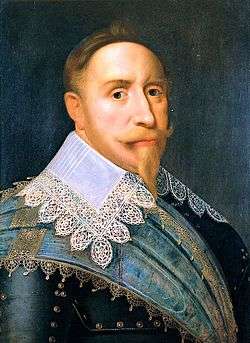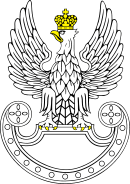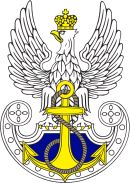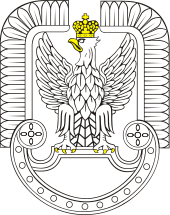Polish–Swedish War (1621–1625)
The Polish–Swedish War of 1621 to 1625 was a war in a long-running series of conflicts between the Polish–Lithuanian Commonwealth and the Swedish Empire. It began with a Swedish invasion of the Polish–Lithuanian fiefdom Livonia. Swedish forces succeeded in taking the city of Riga after a siege. The Commonwealth, focussed on war with the Ottoman Empire (such as the battles of Cecora and Chocim), was unable to send significant forces to stop Gustav Adolf, and signed a truce favorable to Sweden. The Commonwealth ceded Livonia north of the Dvina (Düna) river, and retained only nominal control over Riga. The new truce in Mitau (Jelgava, Mitawa) was signed and lasted from November 1622 to March 1625.

Introduction
The Polish–Swedish War of 1617–18) showed that the Swedish Army, despite several reforms, was still unable to defeat the Polish–Lithuanian Commonwealth. [1] Furthermore, King Gustav Adolf was still regarded in Europe as a usurper. To safeguard the Swedish crown for himself, Gustav Adolf decided to force Sigismund III Vasa to relinquish it. With help from Axel Oxenstierna, the Swedish king introduced a widespread program of military and social reforms, which resulted in creation of a well trained army, based on native recruits. These further reforms and the ongoing conflict between the Commonwealth and the Ottoman Empire (see Polish–Ottoman War (1620–21)), offered Gustav Adolf a further chance to defeat the Commonwealth.[1]
First phase (1621–22)
While the Polish–Lithuanian army was concentrated in Podolia, in the south of the Commonwealth, a Swedish army landed near Pärnu (today part of Estonia), August 19, 1621. It was carried by a fleet of 148 vessels (25 warships, 3 pinnacles, 7 galleys, 7 smaller warships and 106 transport boats).[1] Gustav Adolf had 14,700 infantry, 3,150 cavalry[1] and 375 cannons. The Swedes immediately marched towards Riga, and started a siege on 29 August.[1] The capital of Livonia was defended by a garrison of 300 soldiers, plus 3,700 armed residents.[1] Lithuanian Field Hetman Krzysztof Radziwiłł had only 1,500 soldiers at his disposal, as most units were in Podolia and Red Ruthenia.[1]
Riga capitulated on September 25,[1] after three assaults. On October 2, the Swedes captured the fortress of Dunamunde. The invaders, marching through marshes and forests to avoid Lithuanian cavalry, entered the Duchy of Courland and Semigallia, capturing its capital, Mitau without resistance. The Swedes then tried to capture the fortress of Koknese, but failed to do so, after a skirmish with Lithuanian cavalry of Aleksander Gosiewski.
In early January 1622, the Swedes captured Valmiera, together with several smaller Livonian castles. Meanwhile, the forces under Hetman Radziwiłł grew to 3,000, which enabled the Lithuanians to respond better to Swedish attacks. On January 7, Radziwiłł recaptured Mitau, but because of a lack of artillery, he failed to seize its castle, whose garrison did not capitulate until July 6. A few weeks later, in late July 1622, main Swedish forces reached Mittau, and a prolonged battle ensued.
Since the battle turned into a stalemate, on August 10, 1622, both sides signed a truce, which in 1623 was prolonged until March 1625. During the negotiations, envoys of Gustav Adolf suggested a Swedish–Lithuanian union.
Truce
The Swedish eventually insisted on a truce due to financial problems of the Swedish Empire, as the costs of the war were too high for their treasury. Furthermore, in the autumn of 1621, the Polish–Ottoman War ended (see Battle of Khotyn (1621)), and the army of the Commonwealth was ready to march to Livonia. The truce, signed by the Lithuanians, enraged King Sigismund III Vasa, who planned to transfer all forces northwards, hoping that with the help of the Spanish Navy, he would be able to invade Sweden itself.
Polish nobility and leaders such as Krzysztof Radziwiłł and Krzysztof Zbaraski disagreed with the royal plans. They wanted the King to agree to Swedish terms, and to relinquish the Swedish throne in exchange for a permanent peace treaty and Livonia. Radziwiłł emphasized the fact that after the reforms, the Swedish army was difficult to defeat, and Poland–Lithuania also needed a major overhaul of its armed forces, especially the infantry and artillery. The Commonwealth also needed a strong navy and specialized units of engineers, trained in erection of field fortifications.
Regardless of the opinion of his generals, Sigismund III ordered construction of a fleet, which, with help from the Spanish Empire, was to transport the invading army to Sweden. In 1623, the Polish King met with the Starosta of Puck, Jan Wejher, telling him to build the fleet. However, from the very beginning, this was questioned by the powerful and semi-independent city of Gdańsk, whose government, under Swedish pressure, opposed the very idea of a Commonwealth fleet, and did not allow it to be anchored in its port. Under these circumstances, Sigismund III Wasa decided to expand the port and shipyard of Puck. In 1624-1626, seven medium size ships were built here, with tonnage ranging from 200 to 400 tons. They were manned mostly by local Kashubian fishermen, while marine infantry consisted of English mercenaries, employed by the Polish King since 1621. The biggest ship of the new fleet was the galleon Król Dawid.
Second phase (1625–26)
Before the end of the truce, Gustav Adolf initiated talks with Muscovy and the Ottoman Empire, hoping for a joint attack on Poland–Lithuania. Furthermore, he sent his envoys to Sich, trying to incite the Zaporozhian Cossacks, who were Polish subjects, to attack Turkey, and provoke another Polish–Ottoman war.
On June 27, 1625, Gustav Adolf landed in Livonia with an army of 20,000. The main Swedish corps of almost 10,000 marched upwards the Daugava River, and besieged Koknese, capturing it after sixteen days. On August 27, Swedes captured Tartu, and soon afterwards, Mitau. In early September 1625, Swedish forces invaded the Grand Duchy of Lithuania, capturing Biržai on September 7. This success cut links between Polish–Lithuanian garrisons remaining in Livonia, and those stationed in Lithuania, as Sweden now controlled the line of the Daugava. Furthermore, on September 27 Sweden captured the fortress of Bauska.
Swedish successes were possible also because of a bitter conflict between two powerful Lithuanian hetmans, Krzysztof Radziwiłł and Lew Sapieha. As a result, the armed forces of both leaders did not unite and operated separately, which put the Commonwealth at a disadvantage.
In October 1625, Radziwiłł retook several castles, while Sapieha fought off Swedish assault on Daugavpils. Radziwiłł then concentrated his forces in Courland, sending a few banners to harass Swedish units in Livonia. Meanwhile, Sapieha camped near Valle (Wallhof, southern Latvia), which lies halfway between Bauska and Koknese. Gustav Adolf was well aware of internal divisions among the Lithuanians, and decided to take advantage of it. On January 13, 1626, he concentrated his forces, and on 17 January 1626, the Battle of Wallhof took place,[1] in which for the first time Swedish forces defeated the Commonwealth in open battle. At the Battle of Gniew on 22 Sept. and 29 Sept. to 1 Oct. 1626, the Swedish forces stopped three attacks by the hussars.[1]
Aftermath
After this failure, the Lithuanians limited their activities to attacks on Swedish patrols. Gustav Adolf, on the other hand, was content with the performance of his army, and decided to transfer the war to Royal Prussia[1] (see Polish–Swedish War (1626–29)). During that period, the Battle of Dirschau (17-18 Aug. 1627), the hussars were driven from the field by the Swedish cavalry.[1] The Swedes were victorious again at Górzno on 4 Feb. 1629.[1]
References
- Frost, Robert I. (2000). The Northern Wars: War, State and Society in Northeastern Europe, 1558 - 1721. Pearson Education. pp. 102–104. ISBN 9780582064294.
Further reading
- Mała Encyklopedia Wojskowa, 1967, Wydanie I
- Leszek Podhorodecki, Rapier i koncerz, Warszawa 1985, ISBN 83-05-11452-X
- Leszek Podhorodecki, Wazowie w Polsce, Warszawa 1985, ISBN 83-205-3639-1
- Paweł Jasienica, Rzeczpospolita Obojga Narodów. Srebrny Wiek, Warszawa 1982, ISBN 83-06-01093-0


